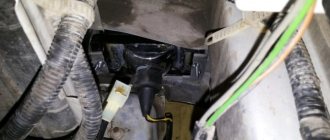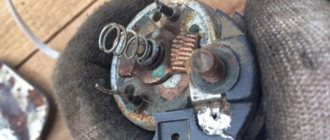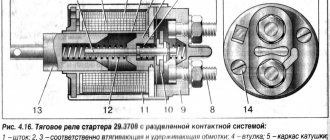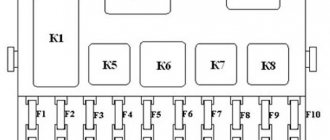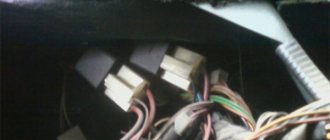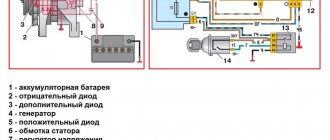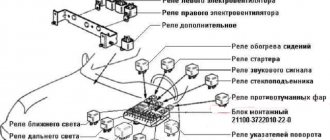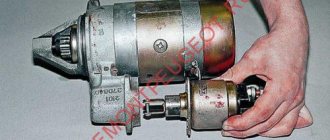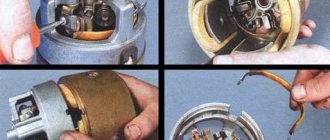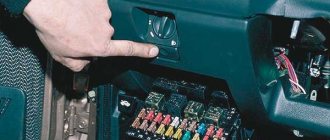It is very possible to start a car engine without using an electric starter. To do this, you will either need to push the car well, or ask someone to take you in tow. But, you must admit, there are not always passengers in the cabin with you who would help you start the car from the pusher, and not every driver you meet will agree to carry you.
Unfortunately, problems with engine starting occur everywhere on domestically produced cars. As for the starter, it itself fails quite rarely. But the parts that ensure its operation often fail.
In this article we will talk about what a starter solenoid relay is and understand its design using the VAZ-2114 as an example. In addition, we will consider its malfunctions, as well as possible malfunctions of other elements of the engine starting system that have similar symptoms.
The design of the starting device and where the starter relay is located on the VAZ-2114
The “fourteenth” starter is a conventional DC electric motor, consisting of:
- housings;
- four-pole armature (rotor);
- Bendix (overrunning clutch);
- solenoid (traction) relay.
The device body is closed with two covers. In the design of an electric motor, it plays the role of a stator. Inside it there is a four-pole armature (shaft with windings), rotating around its horizontal axis. The shaft is supported by two support bearings located in the motor housing.
The Bendix, or overrunning clutch, is a mechanism that engages the armature gear with the crankshaft flywheel ring. It is located at the front of the rotor.
Where is the starter relay located on the VAZ-2114? It is located right on it. Above. In fact, this is not an ordinary, in our understanding, device that closes contacts. It performs two functions at once. It closes the contacts of the armature winding and also drives the bendix and gear.
Where is the starter relay on the VAZ-2114: photo and location + video
If for some reason your car has stopped starting (turning the engine - approx.), then first of all you need to pay attention to the condition of the starter relay.
However, there are two of them in this device, which are radically different both in design and in their purpose. In this article we will look at each of them in detail, talk about their purpose and location in the car.
Operating principle
When the ignition is turned off, the armature, thanks to the spring, is in the extended position. The Bendix gear, however, is not engaged with the flywheel crown. When we turn the ignition key to the second position, voltage is applied to the relay contacts. The magnetic field created by the retractor coil drives the armature. It moves backward, compressing the spring, and closes the contacts through which voltage is supplied to the starter. The retracting winding is turned off at this moment, and the holding winding is turned on.
During movement, the armature moves the fork along the rotor shaft. She, in turn, moves the bendix, bringing the gear into engagement with the flywheel. When we release the ignition key, the voltage on the holding coil stops flowing, and the armature returns to its original position under the influence of the spring. The fork, at the same time, disconnects the Bendix gear and the flywheel crown.
Signs of a malfunctioning retractor relay
A faulty traction relay can be identified by the following symptoms:
- when the ignition is turned on, there is no characteristic click accompanying the movement of the device’s armature to the rearmost position (the starter does not turn, the engine does not start);
- a click is heard, but the trigger does not fire;
- The relay is triggered, the starter starts the engine, but does not turn off.
If you turn on the ignition and find that the engine does not start, and one of the listed signs of a faulty starting device is present, try to find the problem yourself. In some cases, the damage may be on the surface, and it will only take a few minutes to fix it.
No clicking of the solenoid relay
The absence of a click may indicate that either there is no voltage supplied to it, or there are problems with the pull-in winding. First of all, we check the wiring. To do this, visually inspect the positive wire going to the relay from the battery, and then the thin wire from the ignition switch. If possible, check the voltage level with a voltmeter (multimeter), connecting its positive probe to the terminal on the relay from which the wire goes to the battery, and the negative probe to ground. The device should show battery voltage. If this indicator is lower, you need to look for a problem in the wiring.
If there is voltage to the relay, try to start the engine directly, without the ignition switch. To do this, disconnect the wire coming from it and use a screwdriver to close the relay contacts (output to the battery and output to the starter). It worked? Deal with the contact group of the ignition switch.
Starter relay (retractor) for VAZ-2114
This type of relay is located directly on the starter housing, and is controlled by supplying current from the ignition switch.
This type of relay is directly involved in starting the engine, regulating the clutch reaction between currents of different magnitudes (since the ignition voltage is less than the current supplied from the battery - approx.).
Solenoid relay location
It is not difficult to determine the location of the retractor; it is located directly on the starter and has two wires, the first, the smallest in size, comes from the ignition switch, and the second, the largest in size, comes from the battery.
The location of the wires is indicated by arrows.
The relay is located directly on the starter housing.
Relay operating principle
The operation of this relay is as follows:
- When the battery supplies current to the starter coil, due to the magnetic field, the coil acts on the armature.
- When the armature moves, it clamps the spring, from which the bendix is connected to the splines.
- When the contacts close together, the engine starts, and all connections return to their places, disconnecting the fixation points.
Solenoid relay malfunctions and their symptoms
You can first see if there are problems with the solenoid relay visually, since there may be traces of corrosion on the wires, and as a result, the incoming current may simply not pass to its destination. If cleaning these contacts does not lead to anything, then we move on to inspecting the 4-pin relay, usually located on a bolt in the engine compartment.
The relay location is indicated by a red marker.
There is a click, but the starter does not turn
If you clearly hear the relay click when you turn on the ignition, the problem is most likely in the starter itself. Perhaps the brushes are worn out, or there is a break in one of the windings. In any case, further diagnostics without dismantling the device is impossible. If a break in the windings is detected, you can try to restore the starting device by entrusting it to winding winding specialists. If things are generally bad with it, it is better to buy a new starter 2114. The price for it varies between 3700-5000 rubles.
How to replace the VAZ-2114 starter solenoid relay
Now let’s move on to the process of dismantling and replacing the “fourteenth” traction relay. Let us immediately note that for this it is better to remove the starter assembly. This way it will be possible to simultaneously check the condition of its brush assembly and bearings. So, the process of replacing the relay is as follows:
- Remove the negative terminal from the battery.
- Disconnect the wires from the relay terminals and from the terminal of the starter brush assembly.
- Unscrew the bolts securing the starter to the clutch housing. We remove it from its seat.
- Unscrew the coupling bolts securing the relay.
- Disconnect the relay from the starter and install a new one in its place.
- We carry out installation in reverse order.
VAZ 2114 starter relay – let’s take a closer look at the device!
Often, many VAZ 2114 owners are faced with a situation where the car does not start or starts very poorly. There can be many reasons for this behavior of a car, but the first thing everyone looks for is a problem with the starter. One of the main problems in its operation is the relay.
Causes and effects - why won't the car start?
The reluctance of a car to start is often due to a discharged battery. The problem is especially relevant in the winter, when the outside temperature is below zero. The lack of energy to start can be determined by the sound - if you hear a sharp, unpleasant noise of the starter trying to crank and start the engine, then it’s time to recharge. In this case, it is necessary to partially or fully charge the battery, but if time is pressing, you can “light it” from another car.
It is also worth checking if there is an open circuit in the ignition contact group. Partial disconnection of the contacts occurs when the key is turned in the ignition mechanism of the VAZ 2114, in this case the starter will not even try to turn over. To fix this breakdown, you need to remove the plastic from the steering column and reconnect the ignition contacts. In some cases, it is necessary to tighten these terminals with pliers.
The lack of contact mass on the starter of the VAZ 2114 is also a common problem for this series of cars. Due to the slightly unsuccessful design of the engine frame, the starter is very poorly protected from direct contact with water and therefore rust forms on its contacts. If you encounter this problem, you need to re-clean the contact wire and screw it onto the starter solenoid relay. Before carrying out this procedure, you need to remove the terminals from the battery.
Other relay
We figured out where the starter relay is located on the VAZ-2114 and how to replace it. But in the engine starting system there is another part with the same name. Yes, yes, it is also called the “starter relay”. Only extra. And its function is completely different. An additional starter relay serves to ensure the safety of the entire starting mechanism. Without it, the brushes and armature windings would burn almost every time it was started.
You will ask again, where is the starter relay located on the VAZ-2114? On the first models of the “fourteenth” it was located in the engine compartment at the top on the partition separating the engine compartment and the interior. On the new VAZ-2114 it is not there. And some “experts” foam at the mouth and prove that cars of the Samara-2 family do not have it at all.
In fact, there is an additional relay, but it is located under the steering column. Just remove the bottom part of the plastic casing and you will immediately see it. This is a regular four-pin relay labeled 98.3777-10 that protects the starter circuit. If you have problems starting the power unit, do not be lazy to check it too.
Dismantling and replacement
To make it more convenient to replace the relay, it is recommended not to be lazy and still remove the starter itself. This will allow you to simultaneously check the condition of the starter while replacing the relay.
First, disconnect the negative terminal from the battery. Otherwise, you will be seriously shocked. There is little pleasure in this. Plus, this will lead to burnout of the wiring, which will be extremely difficult and time consuming to change.
The removal procedure described below concerns an assembled relay, which has the ability to replace individual structural elements.
- Disconnect the negative terminal from the battery.
- Disconnect the red terminal from the relay. This is a red wire.
- Using an 8 mm wrench, unscrew the nut securing the brush assembly. You will find it behind the relay.
- Remove the contact that this nut held in place.
- Unscrew the fastening of the solenoid relay to ground. We are talking about coupling bolts.
- Next, you need to dismantle the power wire, after which the relay itself is pulled out.
- The fastening nuts are unscrewed from the end part, which allows you to remove the upper part of the relay.
- It is advisable to immediately replace the relay core with a new one.
- Install a new relay.
- Proceeding strictly in reverse order, reassemble the assembly, which will allow you to complete the replacement of the unit.
- When separating the relay into its two component parts, be sure to ensure that the core does not slip out and the spring does not jump out.
We can say that replacing the gearbox on a VAZ 2114 is not so difficult. It is much easier to replace a non-separable relay, since to replace it it is enough to unscrew all the fasteners in the same way and disconnect the contacts.

